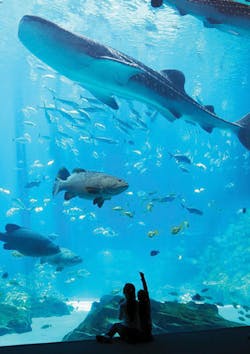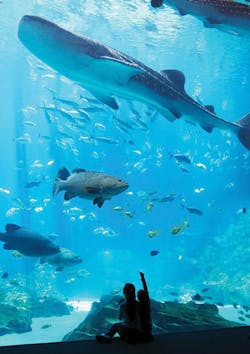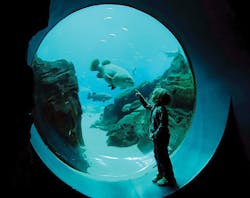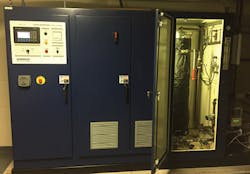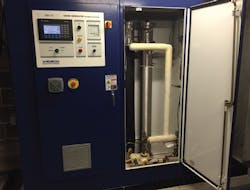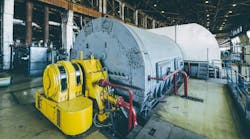By Janet McSwain
While many industries are exploring ways to reduce their waste streams by internally treating, recycling and reusing their water, few have the multiple challenges of the Georgia Aquarium. When it opened in November 2005, it was the world's largest aquarium. Currently, it remains the largest in the western hemisphere and holds a prominent place among the best for public education and as a leader in conservation and research.
The aquarium maintains over 60 different exhibits across six different focus galleries, including the 6.3-million-gallon Ocean Voyager exhibit, home to the whale shark, the world's largest fish. Each gallery represents a different water environment with unique water quality requirements. In total, the Georgia Aquarium contains over 10 million gallons of water, in both freshwater and marine environments. The water treatment facilities are integral not only to the health of the over 100,000 residents but also to the aquarium's entire mission, including research of endangered species, and public awareness and education.
Reuse Is Essential
The Georgia Aquarium faces a unique challenge among large world-class aquariums in that it is land-locked in an area of severely limited water resources. Other large aquariums are located along the coast and have the option of augmenting their water makeup by 10 to 20 percent or more through outside sources. However, exchange water for the Georgia Aquarium is not an option, making reuse a necessity. After the initial filling and treatment, its water system operates as a closed-loop system, recirculating, treating and reusing over 99 percent of water in the exhibits.
For Eric Hall, director of Zoological Operations and Life Support Systems, the goal is to mimic the natural processes of the ocean because, as he put it, "the ocean does them best." The treatment systems are complex, using three types of removal -- mechanical, chemical and biological -- and each gallery has its own dedicated water treatment train. Treatment goals vary from exhibit to exhibit, based upon the needs of the particular aquatic species and the clarity goals based on viewing distances.
Mechanical Removal: Mimicking the Ocean Floor
All treatment starts with mechanical filtration through pressurized sand filters to remove large solids and debris down to the five to 10 micron size. Hall compares this process to waves crashing on the beach and percolating down through the sand.
One hundred percent of the water undergoes this sand filtration process. Though it may vary slightly from gallery to gallery, on average the flow through the primary filtration systems produces a complete turnover every hour, essentially filtering the entire 10 million gallons several times per day.
Chemical Removal: Imitating Wave Action
The foam fractionator, also known as the protein skimmer, follows sand filtration. Targeting dissolved organics, the fractionator uses air bubbles and low doses of ozone to remove the organic particles as well as fats, oils and greases. This process mimics wave action, which creates foams that collect on the beach or form due to wave turbulence, removing the organics from the water. The oxygen-rich process of the foam fractionator leads naturally into the final type of removal, biological.
Biological Treatment: Nitrification and Denitrification
The foam fractionator creates an oxygen-rich water stream, supporting the conditions for an aerobic bacterial biofilm, similar to the biofilms that form on rocks and other fixed surfaces in ocean environments. These biofilms effectively convert the nitrogen from waste materials to nitrates. However, nitrate is extremely toxic to fish and invertebrates, so denitrification is critical.
The aquarium denitrifies through an anaerobic environment created by flowing slowly upward through a column containing elemental sulfur. There, autotrophic sulfur-oxidizing bacteria and facultative anaerobes convert the nitrates to nitrogen gas, denitrifying the stream.
Disinfection and Clarity
Disinfection using ozone again mimics a natural process, namely lightning strikes upon the water. The corona discharge (CD) process for ozone generation uses high-voltage electrical discharges, much like lightning, to split the diatomic oxygen molecules, some of which recombine to form ozone. As with the other treatment processes, each gallery has its dedicated Wedeco ozone equipment. One Wedeco SMO-40 generator provides the ozone for the Ocean Voyager, while other galleries or exhibits are treated using smaller SMO-10 and GSO-30 generators.
Factors determining the side-stream flow and equipment sizing include the disinfection requirements of the inhabitants, the contaminant loading and the salinity of the water. In general, the units deliver a 3-log disinfection level. Ozone's powerful oxidation not only destroys bacteria and viruses but also breaks down recalcitrant organics including contaminants of emerging concern. However, the overriding factor for equipment sizing is often clarity. Ozone removes color, providing the crystal-clear clarity that provides the public with the optimal experience when viewing the exhibits through the thick acrylic viewing windows.
The final steps combine all the side streams for degasification to remove excess gases, followed by one final pass through an ultraviolet disinfection unit before flowing back into the exhibit.
Balancing Clarity and Quality
For Hall and his team of life support staff, the biggest challenge is balancing water quality with water clarity, which are not the same thing. "Healthy water is not always clear, and clear water is not always healthy," he noted. The health of the aquatic species actually requires a much lower level of water clarity than the clarity required for the optimal viewing experience for the public. However, public engagement and education are vital aspects of the aquarium's mission, and viewing clarity is central to those goals.
Day-to-day operational challenges center around how to measure the level of ozone applied to the water. The aquarium currently relies on oxidation-reduction potential (ORP) sensors to control ozone dosages. However, many variables can affect ORP readings, and accounting for those variables in the control protocols requires experience. In addition, sustainable operations require adapting to changing requirements while maintaining energy efficiency. The units are equipped with variable frequency drives that are highly energy efficient, with a 100-to-1 turndown capability, enabling very precise adjustments to meet process needs while conserving energy.
Ozone: Beyond Disinfection and Clarity
Destruction of pharmaceuticals and other recalcitrant chemical contaminants is yet another of ozone's capabilities. As required by many captive populations, the Georgia Aquarium uses low levels of pharmaceuticals prophylactically to prevent diseases. As a side-stream process, ozone does not interfere with maintaining these low levels. However, an outbreak of disease may require increasing the pharmaceutical dosages to therapeutic levels. Bringing pharmaceutical concentrations up to treatment levels requires discontinuing the ozone for the duration of treatment, typically a week. Following treatment, the reintroduction of ozone destroys the residual pharmaceuticals and allows the water in the exhibit to return to normal levels.
In selecting a partner to provide the ozone expertise and equipment, Hall needed someone who understood the interaction of all the process parameters and all the major and minor roles that ozone plays in the treatment processes. "It is simply not enough to understand ozone production," he said. "You must be aware of all the nuances of the system and how they interact." Wedeco has an established record of serving all the SeaWorld parks worldwide for years, developing in-depth understanding and earning that needed trust.
Reuse: A Decade of Experience
When the Georgia Aquarium opened a decade ago, reuse was not yet a key driver in most industries, but it was an absolute necessity for this facility. Ozone has proven its ability to meet multiple treatment objectives and provide crystal-clear water quality to meet the goals of the aquarium, safeguarding the health of the residents and providing a connection with the public.
The ozone provides "the needed disinfection for the tank water to protect the animals in our care and helps in keeping the water as clear as possible, giving visitors the clear view that makes all the difference," said Alan Grosse, the Life Support Systems technician who oversees the operation and service of the ozone systems. It enables reuse that is safe, sustainable and essential. No other aquarium has so difficult a task nor so clear a mission.
About the Author: Janet McSwain is a professional engineer and freelance writer focusing on the water and wastewater industries.
